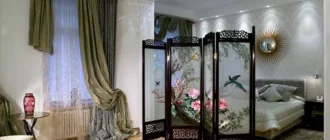Grunge (from the French la grange – “barn” or “hayloft”) is an interior design style characterized by a harmonious combination of simplicity and solidity, as well as the absence of elements of ostentatious luxury. Grunge attracts people with its accessibility and restraint, comfort and abundance of free space.
it is an unusual, yet very attractive combination of rustic coziness and urban practicality. Visually, this style is somewhat reminiscent of a loft, but it completely lacks post-industrial motives (deliberately exposed pipes, iron floor beams, ventilation ducts and shafts).

Interior features in grunge style
Grunge is an interior style designed for spacious rooms with large windows and high ceilings. It is not at all suitable for small apartments in high-rise buildings, but it is ideal for a large country house built on an individual project.
The distinctive features of grunge include:
- The complete absence of pretentious details in the wall cladding (stucco, gilding or unusual carved elements).
- Interior decoration using simple natural materials (stone, brick, wood).
- Wide use of forged decorative elements (lattices, frames, furniture legs, massive chandeliers on chains).
- Presence in the setting of antique or artificially aged furniture with flowing simple shapes.
- Calm and discreet color palette of room decoration.
- The minimum amount of souvenirs, dishes, figurines and other decor.
Grunge floors are usually made from parquet, parquet boards or tiles that artfully imitate the texture of natural stone. Designers also offer to complement the cozy atmosphere with single-color long pile carpets. Dimensional blackout curtains for windows are selected from fabrics of a simple texture without pretentious ornaments or patterns.

A classic-style portrait in a massive frame will rightfully become a highlight of the interior in the grunge style, and several small figurines will gracefully complement the atmosphere of a cozy home. Wicker furniture and not oversized floor lamps with fabric shades will also fit perfectly into this sophisticated setting.
History
The history of grunge dates back almost 2 centuries and originates in post-revolutionary France in the 20s of the XIX century. In those days, the dominant style of interior design in most European countries was strict classicism, the interest in which was maintained thanks to the mass enthusiasm of society for antique art.
But the rapid development of the industrial era made a significant part of the townspeople want to go to the countryside, at least for a short time, away from the hustle and bustle. Many Frenchmen began to equip themselves in the provinces with inexpensive comfortable housing with elements of village life. For these purposes, the most affordable materials were used, and the homeowners deliberately refused luxury items in favor of practicality and comfort.

This is how grunge appeared, which in many ways became the obvious opposite of classicism. The new style remained provincial for a long time, despite the growing popularity among the middle class.
The situation changed dramatically only in the second half of the twentieth century. At this time, a boom in consumerism began in the United States and Western Europe, and the standard of living rose significantly. This has caused an increase in demand in the housing market and in the field of interior design. Along with the emergence of new styles, the attitude of people towards the old principles of the arrangement of living quarters has changed.
Grunge finally finally got rid of the provincial label and gained a large number of fans in large metropolitan areas. This charming style remains in demand in the coming 21st century, despite the huge number of alternative housing design options.
Grunge style in design, photo




























